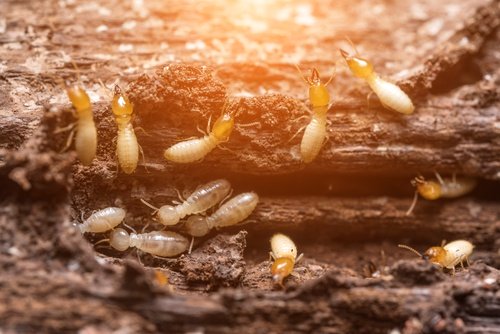Pests of any kind are unwelcome by homeowners, but termites are a particular breed of trouble. These little creatures are some of the most damaging insects out there. They can start swarming as early as February in Houston, feeding on the wood in and around homes.
Because they’re hard to detect, they can rake up thousands of dollars of damage before you realize they’re even there. With the right knowledge, you can prevent this. Protect your home this spring by learning about the different types of termites that are native to the Houston area, and what you can do about them.
Drywood Termites
Drywood termites are small, yellowish-brown pests that are more common in dryer, more arid areas. They live in colonies of up to 2,5000 and can be spotted swarming from home to home, invading houses through wood sidings and attics. They’re also known to tunnel through other wooden structures, creating moisture that can cause warping.
These termites can chew through support beams, floors, and walls. They can also infiltrate homes by being transported to new locations via infested pieces of furniture, like wooden picture frames or chairs.
Subterranean Termites
Subterranean termites are far more common than Drywood termites, making them slightly more notorious than their relatives. The average colony size of these termites is around 200,000 but can reach up to two million. These pests fall into three main categories:
- Reproductive: These termites can lay hundreds of eggs a day, gradually increasing to 500 daily. They’re winged, so they can fly to select a mate.
- Worker: These termites do all of the work within the colony, from foraging new tunnels to caring for the young, to building and maintaining their nest.
- Soldier: With larger, stronger jaws, these pests help defend the colony from any intruders, including ants and foreign termites.
All variations of the Subterranean termite live underground, near soil lines, and are driven by moisture. They feed on softer materials, like rotted wood, drywall backing, or wooden foundations. Due to their colony size and ability to live undetected, these termites can be the most destructive of any breed.
Read More – 3 Reasons Termites Go Undetected
Formosan Termites
While Formosan termites are in the subterranean family, they’re able to live and nest above ground that has access to moisture, making them a slightly different breed. They’re local to southern states, and have a translucent orange color. They’ve been referred to as the “super termite” because they’re more aggressive than their counterparts.
Like their Subterranean family members, Formosan termites live in large colonies, with some reaching up to one million in size. Their reproductive females can potentially lay up to 1,000 eggs a day, helping to grow their sizes. Again, similar to other species, they feed on wood and paper products and can be found under porches, wooden beams, and utility poles.
Unlike Drywood and Subterranean termites, they attack plants and asphalt, plastic, and rubber materials in the hunt for food. They also create “carton nests” made up Silvia, chewed wood, and excrement, instead of living in the soil.
Read More – [Infographic] The Difference Between Flying Ants and Termites
What Are the Signs of a Termite Infestation?
If you’re worried you may have either Drywood, Subterranean, or Formosan termites living in or around your home, here are some common indicators to look for:
- Mud tubes. A mud tube is made up of small pieces of soil and wood and can be found around the perimeter of a structure, such as your foundation, walls, or garage.
- Damage to wood. Termites feed on wood and wooden structures, leaving behind small holes and other signs of damage. They also cause rundown drywall, warped structures, or floor damage.
- Discarded wings. A termite sheds its wings when they leave to start a new colony. Unneeded wings can be found near entryways.
- Swarms: Termites travel in large groups or swarms. Drywood termites typically swarm at night, while Subterranean swarm during the day. Spotting a termite swarm is the clearest indication you have an infestation.
Read More – Termites Swarming: Facts You Need to Know
How Do I Prevent a Termite Infestation?
There are certain things you can do to ward off termites from infiltrating your home. These methods include:
- Reducing Moisture: Termites need moisture to survive, so keeping moisture levels low in your home can prevent termites from finding it an attractive place to colonize. Be sure to fix leaky faucets and water pipes.
- Replacing any Rotting or Decaying Wood: Termites’ primary food source is damp and rotting wood. Maintaining the wood on the outer parts of your house is crucial to keeping these pests out.
- Storing Firewood Away from Your Home: Keeping firewood at least 20 feet away from your home eliminates a nesting area for termites.
- Keeping Soil at a Safe Distance: Soil is a prime place for Subterranean and Formosan termites to colonize. Keeping flowerbeds and potted plants at least 18 inches from the foundation of your home can create a termite barrier.
- Staying Vigilant: Keeping the exterior of your home and yard well maintained is key to prevention. Be sure to replace or discard any rotting wood that may be on your house or in your yard.
What Should I Do if I Have an Infestation?
Termites can cause severe structural damage to your home, but knowing the signs of termites and how to prevent them from running amok can protect your home from these tiny terrors. However, even with the best effort, termites can still slip in undetected. To ensure your home is termite-free for good, give us a call at 281-469-2679 or schedule an appointment with us today.



